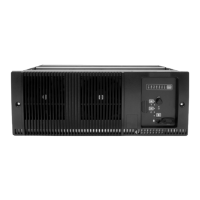TB9100/P25 CG/P25 TAG Installation and Operation Manual Technical Description 123
© Tait Limited March 2014
8.3 PA Module Operation
The PA is a modular design with the circuitry divided among separate
boards which are assembled in different configurations in different models.
Interconnect boards are used in certain models to connect boards that are
physically separated on the heatsink. The 5, 50 and 100W PAs are available
for operation on 28VDC, while the 5 and 50W PAs are also available for
operation on 12VDC.
Figure 8.4 on page 125 shows the configurations of a 100W 28V PA and a
50W 12V PA, along with the main inputs and outputs for power, RF and
control signals.
PAs can only be installed in position 3 or position 5 of the subrack. Refer
to “Configuring the Subrack Interconnect Board” on page 112 for more
information.
RF Circuitry The RF output from the reciter is fed first to the 6W driver board. In the
100W model the output from the 6W driver board is fed into a –3dB
hybrid coupler on a separate splitter board and then to two 60W final boards
in quadrature. The outputs from these two boards are then combined by
another –3dB hybrid coupler on a separate combiner board before being fed
to the low-pass filter (LPF)/directional coupler board.
In the 50W model, the output from the 6W driver board is fed to one 60W
final board and then to the LPF/directional coupler board. In the 5W
model, the output from the 6W driver board is fed directly to the LPF/
directional coupler board.
Control Circuitry The microprocessor located on the control board monitors and controls the
operation of the PA. There are no manual adjustments in the PA because all
the calibration voltages and currents required to control and protect the PA
are monitored by the microprocessor. The software also automatically
detects the PA configuration and controls the PA accordingly.
If any of the monitored conditions exceeds its normal range of values, the
microprocessor will generate an alarm and reduce the output power to a
preset level (foldback). If the measured values do not return within the
normal range after foldback, the PA will be shut down (refer to “Power
Foldback” on page 124).
The alarms and diagnostic functions are accessed through I
2
C bus messages
on the system control bus via the reciter, control panel and CSS. Some
measurements are logged by the microprocessor and this information can
also be accessed through the system control bus.
The operation of the cooling fan mounted on the front panel is determined
by the temperature limits set in the PA software.

